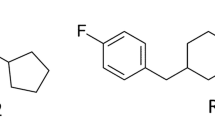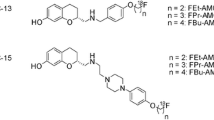Abstract
Purpose
Positron emission tomography (PET) imaging of serotonin 2A (5-HT2A) receptors with agonist tracers holds promise for the selective labelling of 5-HT2A receptors in their high-affinity state. We have previously validated [11C]Cimbi-5 and found that it is a 5-HT2A receptor agonist PET tracer. In an attempt to further optimize the target-to-background binding ratio, we modified the chemical structure of the phenethylamine backbone and carbon-11 labelling site of [11C]Cimbi-5 in different ways. Here, we present the in vivo validation of nine novel 5-HT2A receptor agonist PET tracers in the pig brain.
Methods
Each radiotracer was injected intravenously into anaesthetized Danish Landrace pigs, and the pigs were subsequently scanned for 90 min in a high-resolution research tomography scanner. To evaluate 5-HT2A receptor binding, cortical nondisplaceable binding potentials (BPND) were calculated using the simplified reference tissue model with the cerebellum as a reference region.
Results
After intravenous injection, all compounds entered the brain and distributed preferentially into the cortical areas, in accordance with the known 5-HT2A receptor distribution. The largest target-to-background binding ratio was found for [11C]Cimbi-36 which also had a high brain uptake compared to its analogues. The cortical binding of [11C]Cimbi-36 was decreased by pretreatment with ketanserin, supporting 5-HT2A receptor selectivity in vivo. [11C]Cimbi-82 and [11C]Cimbi-21 showed lower cortical BPND, while [11C]Cimbi-27, [11C]Cimbi-29, [11C]Cimbi-31 and [11C]Cimbi-88 gave rise to cortical BPND similar to that of [11C]Cimbi-5.
Conclusion
[11C]Cimbi-36 is currently the most promising candidate for investigation of 5-HT2A receptor agonist binding in the living human brain with PET.







Similar content being viewed by others
References
Gonzalez-Maeso J, Weisstaub NV, Zhou M, et al. Hallucinogens recruit specific cortical 5-HT(2A) receptor-mediated signaling pathways to affect behavior. Neuron. 2007;53:439–52.
Abbas A, Roth BL. Pimavanserin tartrate: a 5-HT2A inverse agonist with potential for treating various neuropsychiatric disorders. Expert Opin Pharmacother. 2008;9:3251–9.
Pinborg LH, Adams KH, Svarer C, et al. Quantification of 5-HT2A receptors in the human brain using [18F]altanserin-PET and the bolus/infusion approach. J Cereb Blood Flow Metab. 2003;23:985–96.
Ito H, Nyberg S, Halldin C, Lundkvist C, Farde L. PET imaging of central 5-HT2A receptors with carbon-11-MDL 100,907. J Nucl Med. 1998;39:208–14.
Fitzgerald LW, Conklin DS, Krause CM, et al. High-affinity agonist binding correlates with efficacy (intrinsic activity) at the human serotonin 5-HT2A and 5-HT2C receptors: evidence favoring the ternary complex and two-state models of agonist action. J Neurochem. 1999;72:2127–34.
Song J, Hanniford D, Doucette C, et al. Development of homogeneous high-affinity agonist binding assays for 5-HT2 receptor subtypes. Assay Drug Dev Technol. 2005;3:649–59.
Cornea-Hebert V, Watkins KC, Roth BL, et al. Similar ultrastructural distribution of the 5-HT(2A) serotonin receptor and microtubule-associated protein MAP1A in cortical dendrites of adult rat. Neuroscience. 2002;113:23–35.
Peddie CJ, Davies HA, Colyer FM, Stewart MG, Rodriguez JJ. Colocalisation of serotonin2A receptors with the glutamate receptor subunits NR1 and GluR2 in the dentate gyrus: an ultrastructural study of a modulatory role. Exp Neurol. 2008;211:561–73.
Cumming P, Wong DF, Gillings N, Hilton J, Scheffel U, Gjedde A. Specific binding of [(11)C]raclopride and N-[(3)H]propyl-norapomorphine to dopamine receptors in living mouse striatum: occupancy by endogenous dopamine and guanosine triphosphate-free G protein. J Cereb Blood Flow Metab. 2002;22:596–604.
Braden MR, Parrish JC, Naylor JC, Nichols DE. Molecular interaction of serotonin 5-HT2A receptor residues Phe339(6.51) and Phe340(6.52) with superpotent N-benzyl phenethylamine agonists. Mol Pharmacol. 2006;70:1956–64.
Nichols DE, Frescas SP, Chemel BR, Rehder KS, Zhong D, Lewin AH. High specific activity tritium-labeled N-(2-methoxybenzyl)-2,5-dimethoxy-4-iodophenethylamine (INBMeO): a high-affinity 5-HT2A receptor-selective agonist radioligand. Bioorg Med Chem. 2008;16:6116–23.
Ettrup A, Palner M, Gillings N, Santini MA, Hansen M, Kornum BR, et al. Radiosynthesis and evaluation of 11C-CIMBI-5 as a 5-HT2A receptor agonist radioligand for PET. J Nucl Med. 2010;51:1763–70.
Narendran R, Mason NS, Laymon CM, et al. A comparative evaluation of the dopamine D(2/3) agonist radiotracer [11C](-)-N-propyl-norapomorphine and antagonist [11C]raclopride to measure amphetamine-induced dopamine release in the human striatum. J Pharmacol Exp Ther. 2010;333:533–9.
Narendran R, Hwang DR, Slifstein M, et al. In vivo vulnerability to competition by endogenous dopamine: comparison of the D2 receptor agonist radiotracer (-)-N-[11C]propyl-norapomorphine ([11C]NPA) with the D2 receptor antagonist radiotracer [11C]-raclopride. Synapse. 2004;52:188–208.
Paterson LM, Tyacke RJ, Nutt DJ, Knudsen GM. Measuring endogenous 5-HT release by emission tomography: promises and pitfalls. J Cereb Blood Flow Metab. 2010;30:1682–706.
Shulgin A, Shulgin A. PIHKAL, a chemical love story. Berkeley, CA: Transform Press; 1991. p. 1–978.
Nichols DE, Frescas S, Marona-Lewicka D, et al. 1-(2,5-Dimethoxy-4-(trifluoromethyl)phenyl)-2-aminopropane: a potent serotonin 5-HT2A/2C agonist. J Med Chem. 1994;37:4346–51.
Monte AP, Marona-Lewicka D, Parker MA, Wainscott DB, Nelson DL, Nichols DE. Dihydrobenzofuran analogues of hallucinogens. 3. Models of 4-substituted (2,5-dimethoxyphenyl)alkylamine derivatives with rigidified methoxy groups. J Med Chem. 1996;39:2953–61.
Herth MM, Kramer V, Piel M, et al. Synthesis and in vitro affinities of various MDL 100907 derivatives as potential 18F-radioligands for 5-HT2A receptor imaging with PET. Bioorg Med Chem. 2009;17:2989–3002.
Sureau FC, Reader AJ, Comtat C, et al. Impact of image-space resolution modeling for studies with the high-resolution research tomograph. J Nucl Med. 2008;49:1000–8.
Watanabe H, Andersen F, Simonsen CZ, Evans SM, Gjedde A, Cumming P. MR-based statistical atlas of the Gottingen minipig brain. Neuroimage. 2001;14:1089–96.
Kornum BR, Lind NM, Gillings N, Marner L, Andersen F, Knudsen GM. Evaluation of the novel 5-HT4 receptor PET ligand [11C]SB207145 in the Gottingen minipig. J Cereb Blood Flow Metab. 2009;29:186–96.
Lammertsma AA, Hume SP. Simplified reference tissue model for PET receptor studies. Neuroimage. 1996;4:153–8.
Gillings N. A restricted access material for rapid analysis of [11C]-labeled radiopharmaceuticals and their metabolites in plasma. Nucl Med Biol. 2009;36:961–5.
Meyer PT, Bhagwagar Z, Cowen PJ, Cunningham VJ, Grasby PM, Hinz R. Simplified quantification of 5-HT2A receptors in the human brain with [11C]MDL 100,907 PET and non-invasive kinetic analyses. Neuroimage. 2010;50:984–93.
Kristiansen H, Elfving B, Plenge P, Pinborg LH, Gillings N, Knudsen GM. Binding characteristics of the 5-HT2A receptor antagonists altanserin and MDL 100907. Synapse. 2005;58:249–57.
Marazziti D, Rossi A, Giannaccini G, et al. Distribution and characterization of [3H]mesulergine binding in human brain postmortem. Eur Neuropsychopharmacol. 1999;10:21–6.
Innis RB, Cunningham VJ, Delforge J, et al. Consensus nomenclature for in vivo imaging of reversibly binding radioligands. J Cereb Blood Flow Metab. 2007;27:1533–9.
Guo Q, Brady M, Gunn RN. A biomathematical modeling approach to central nervous system radioligand discovery and development. J Nucl Med. 2009;50:1715–23.
Ewald AH, Fritschi G, Maurer HH. Metabolism and toxicological detection of the designer drug 4-iodo-2,5-dimethoxy-amphetamine (DOI) in rat urine using gas chromatography-mass spectrometry. J Chromatogr B Analyt Technol Biomed Life Sci. 2007;857:170–4.
Theobald DS, Putz M, Schneider E, Maurer HH. New designer drug 4-iodo-2,5-dimethoxy-beta-phenethylamine (2C-I): studies on its metabolism and toxicological detection in rat urine using gas chromatographic/mass spectrometric and capillary electrophoretic/mass spectrometric techniques. J Mass Spectrom. 2006;41:872–86.
Acknowledgments
The technical assistance of Letty Klarskov, Mette Værum Olesen, Bente Dall and Jack Frausing Nielsen is gratefully acknowledged. This study was financially supported by the Lundbeck Foundation, University of Copenhagen, Faculty of Health Sciences, the Toyota Foundation, the John and Birthe Meyer Foundation, and by the EU 6th Framework program DiMI (LSHB-CT-2005-512146). [3H]MDL100907 was kindly provided by Prof. Christer Halldin, Karolinska Institute, Sweden. K i determinations at neuroreceptors were generously provided by the National Institute of Mental Health's Psychoactive Drug Screening Program, Contract no. HHSN-271-2008-00025-C (NIMH PDSP). The NIMH PDSP is directed by Bryan L. Roth, MD PhD, at the University of North Carolina at Chapel Hill, and Project Officer Jamie Driscol at NIMH, Bethesda MD, USA.
Conflicts of interest
None.
Author information
Authors and Affiliations
Corresponding author
Electronic supplementary material
Below is the link to the electronic supplementary material.
ESM 1
(DOC 264 kb)
Rights and permissions
About this article
Cite this article
Ettrup, A., Hansen, M., Santini, M.A. et al. Radiosynthesis and in vivo evaluation of a series of substituted 11C-phenethylamines as 5-HT2A agonist PET tracers. Eur J Nucl Med Mol Imaging 38, 681–693 (2011). https://doi.org/10.1007/s00259-010-1686-8
Received:
Accepted:
Published:
Issue Date:
DOI: https://doi.org/10.1007/s00259-010-1686-8




